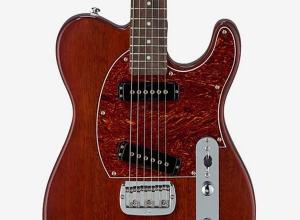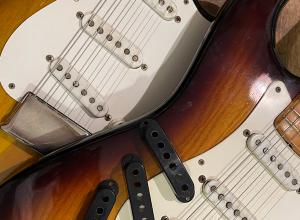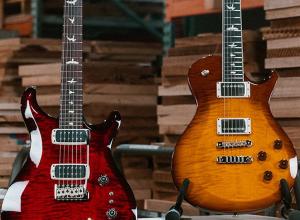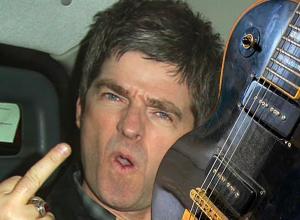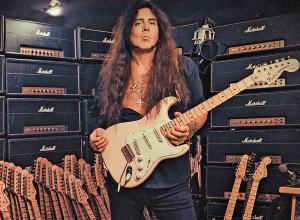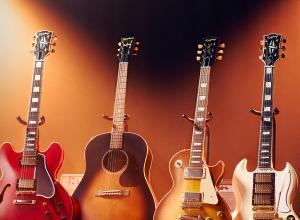Sono i primi anni ’60, gli anni del boom in Occidente, che portano anche nel mondo degli strumenti musicali un marketing sempre più aggressivo, la corsa alla crescita dei ricavi che impone da un lato la continua commercializzazione di novità, dall’altro drastici tagli dei costi. La richiesta di spingere le vendite è pressante, ma per stare nei budget i progettisti devono accettare strategie produttive sempre meno compatibili con la tradizione di qualità e cura dei dettagli che aveva fatto la fortuna degli strumenti americani nella prima metà del secolo, non a caso definita la Golden Era.
Anche Gibson è vittima di questa novelle vague commerciale, soprattutto nel settore delle solid body. Nel 1960 la Les Paul Standard viene abbandonata in favore di una chitarra più piccola, leggera, sottile, quindi totalmente diversa, che però porta lo stesso nome. Les Paul, l’uomo che le dà il nome, si ribella, la nuova chitarra non gli piace proprio e interrompe l’endorsement, tanto che Gibson è costretta a togliere il suo nome dalla chitarra, che diventa semplicemente SG (Solid Guitar), nota il Italia anche come “diavoletto”. La SG si conquisterà un importante spazio proprio nel mondo della musica, ma non può a sostituire la Les Paul, che i musicisti cominciano a chiedere a gran voce.
![1968-1993: i primi 25 anni di riedizioni Les Paul [IT-EN] 1968-1993: i primi 25 anni di riedizioni Les Paul [IT-EN]](https://www.accordo.it/cloud-assets/00/redazionea5a/images/153433lp-1.jpg)
Nel 1967 il management di Kalamazoo si accorge che togliere dal catalogo la Les Paul è stato un grosso errore, anche perché i musicisti più amati, tra cui Michael Bloomfield ed Eric Clapton, continuano a preferire le Les Paul del 1959 ai nuovi modelli. E allora ecco che nel 1968 torna in catalogo una Les Paul gold top con caratteristiche simili a quella del 1955 con i pickup P90.
![1968-1993: i primi 25 anni di riedizioni Les Paul [IT-EN] 1968-1993: i primi 25 anni di riedizioni Les Paul [IT-EN]](https://www.accordo.it/cloud-assets/00/redazionea5a/images/153433lp-2.jpg)
C’è una preserie di pochi esemplari costruiti tra il luglio e il settembre 1968 (in genere hanno la scritta Les Paul sul copri trussrod e la corona al centro della paletta come la 335), poi arriva la serie definitiva, inizialmente con il corpo in un unico pezzo di mogano con top in due pezzi di acero uniti al centro, paletta stretta in stile anni ’50 e manico in un unico pezzo di mogano e scritta Les Paul in oro al centro. È una buona chitarra, ma non è certo la Les Paul 1959.
L’anno dopo la paletta si allarga, uniformandosi a quella della Custom, il manico diventa in tre pezzi (più economico da produrre), i P90 sono sostituiti dai mini humbucker e la chitarra acquista il nome “Les Paul Deluxe”.
![1968-1993: i primi 25 anni di riedizioni Les Paul [IT-EN] 1968-1993: i primi 25 anni di riedizioni Les Paul [IT-EN]](https://www.accordo.it/cloud-assets/00/redazionea5a/images/153434lp-3.jpg)
Con la fine del 1969 il top viene realizzato con tre o più pezzi di acero affiancati (tanto c’è la vernice d’oro a coprire tutto) e il manico acquista una bozza di rinforzo all’attacco con la paletta, quella “voluta” tanto disprezzata dai collezionisti. Nonostante l’impegno profuso dalla nuova proprietà (nel 1969 la Gibson viene acquistata dal gruppo sudamericano Norlin), le Les Paul prodotte a inizio degli anni ’70 sono prive del suono, della suonabilità e del fascino che rendono unica la iconica flametop del 1959. Bisogna attendere il 1975 perché qualcuno si presenti alla porta della fabbrica di Kalamazoo e lo dica apertamente.
Les Paul Strings & Things
![1968-1993: i primi 25 anni di riedizioni Les Paul [IT-EN] 1968-1993: i primi 25 anni di riedizioni Les Paul [IT-EN]](https://www.accordo.it/cloud-assets/00/redazionea5a/images/153434lp-4.jpg)
Questo qualcuno è Chris Lovell, manager di Strings & Things di Memphis, un negozio all’epoca molto frequentato dai musicisti di grido, molti dei quali sono alla ricerca delle ultime Les Paul, le sunburst degli anni 1958-1960. Lovell ordina in esclusiva una serie di Les Paul con top sunburst in acero fiammato accoppiato al centro, paletta piccola, binding sottile nel cutaway. Secondo i registri Gibson ne vengono costruite poco meno di 30 nel giro di tre anni. Sono i primi tentativi di replica della iconica “Flametop” originale e oggi sono difficili da individuare, perché non hanno una numerazione specifica o una qualunque marcatura che consenta di riconoscerli. Le poche chitarre certificate sono quelle di cui la ricevuta di acquisto è sopravvissuta al tempo.
Les Paul KM
![1968-1993: i primi 25 anni di riedizioni Les Paul [IT-EN] 1968-1993: i primi 25 anni di riedizioni Les Paul [IT-EN]](https://www.accordo.it/cloud-assets/00/redazionea5a/images/153434lp-5.jpg)
Nel 1979 la pressione dei rivenditori convince Gibson che bisogna rispondere alle richieste sempre più pressanti dei musicisti che chiedono una Les Paul come quella abbandonata vent’anni prima. Il reparto ricerca e sviluppo prova a inventarsi qualcosa, ma a quell’epoca non esiste in Gibson un solo strumento del passato da poter esaminare e copiare. Soprattutto manca la percezione dei dettagli che fanno della Flametop uno strumento perfetto. Viene messa in produzione la Les Paul KM (che sta per Kalamazoo), con i pickup a bobine crema senza cover metallica (a scimmiottare l’uso dell’epoca di togliere le cover nell’illusione di avere maggior output) e una tavola in acero con una fiammatura dignitosa e ben accoppiato al centro. Tutto il resto non si discosta dalla produzione di serie: palettona, meccaniche Grover, speed knobs, ponte Nashville, manico in tre pezzi, voluta e logo sbagliato. In totale se ne producono 1500 esemplari circa, che vengono comunque venduti bene. Una buona chitarra, ma anni luce distante dalla ’59 autentica.
Esperimenti a Kalamazoo
Tra il 1980 e il 1982 nella fabbrica si diffonde la notizia della prossima dismissione della fabbrica di Kalamazoo. I liutai cercano di far cambiare idea al management proponendo strumenti che possano dimostrare la loro superiorità rispetto ai colleghi della neonata fabbrica di Nashville. L’impegno non sarà sufficiente e Kalamazoo chiuderà nel 1983, ma l’impegno delle maestranze che lottano per la sopravvivenza della storica fabbrica porta alla nascita di una serie di chitarre di altissimo livello. Sono quasi tutte pezzi unici, non hanno numeri di serie speciali o altre sigle di riferimento, ma sono quasi tutte ispirate alla Flametop del 1959 (a margine va notato che nel 1982 a Kalamazoo vengono prodotte anche le prime repliche fedeli delle tre chitarre “modernistiche”, Explorer, Flying V e Moderne in korina, strumenti di altissima qualità che nel tempo hanno raggiunto quotazioni elevatissime).
Con la chiusura di Kalamazoo alcuni dei liutai si mettono in proprio, dando origine alla Heritage, che negli stessi locali continua ancora oggi a produrre in piccole quantità strumenti di altissimo livello.
Le Les Paul Guitar Trader e Leo’s
Negli stessi anni ci sono due importanti rivenditori Gibson che chiedono delle Les Paul quanto più vicine possibile all’originale del 1959. Il primo è Leo’s Music di Oakland, California e il secondo, a distanza di poche settimane, è Guitar Trader di Red Bank, New Jersey.
![1968-1993: i primi 25 anni di riedizioni Les Paul [IT-EN] 1968-1993: i primi 25 anni di riedizioni Les Paul [IT-EN]](https://www.accordo.it/cloud-assets/00/redazionea5a/images/153434lp-6.jpg)
Il responsabile commerciale di Leo’s, Rick Bandoni, è un collezionista Gibson e ha eccellenti contatti in Giappone, dove Tokai sta producendo le migliori copie Les Paul 1959 in circolazione alòl’epoca. Rick porta a Kalamazoo una Tokai e chiede di usarla come campione da copiare, poi entra nel magazzino dei legni e sceglie personalmente le migliori tavole di acero per i top. A Kalamazoo verranno costruite circa 500 Leo’s Les Paul in due anni, di cui la metà destinata al Giappone, poi la produzione passerà a Nashville (nota: quelle di Kalamazoo si distinguono per il doppio numero di serie, uno tipo vintage dietro la paletta e uno a otto cifre nella cava controlli).
![1968-1993: i primi 25 anni di riedizioni Les Paul [IT-EN] 1968-1993: i primi 25 anni di riedizioni Les Paul [IT-EN]](https://www.accordo.it/cloud-assets/00/redazionea5a/images/153434lp-7.jpg)
Quasi in contemporanea Tim Kummer, responsabile commerciale di Guitar Trader, chiede a Gibson la stessa cosa: delle Les Paul quanto più simili all’originale del 1959. Anche Tim sceglie personalmente legni di altissimo livello. Da Kalamazoo usciranno 47 Les Paul Guitar Trader, strumenti splendidi, di cui i primi 15 equipaggiati con pickup PAF originali del 1958-60 presi dal magazzino ricambi di Guitar Trader, senza supplemento di prezzo. La chitarra viene offerta a 1.500 dollari sul primo numero del catalogo di Guitar Trader. A parte il prototipo, che è decisamente cherry sunburst, le altre Guitar Trader hanno tutte un sunburst più sobrio che si avvicina al brown sunburst. Queste 47 chitarre sono oggi tra le repliche Les Paul più ricercate e vengon scambiate a prezzi altissimi. Rispetto alle Leo’s hanno il logo più fedele all’originale con la “b” e la “o” aperte e il punto sulla “i”. Sono riconoscibili dal doppio numero di serie: quello in stile vintage sulla paletta 9-09xx e quello nella cava a otto cifre.
Les Paul Standard ’80 Heritage
![1968-1993: i primi 25 anni di riedizioni Les Paul [IT-EN] 1968-1993: i primi 25 anni di riedizioni Les Paul [IT-EN]](https://www.accordo.it/cloud-assets/00/redazionea5a/images/153434lp-8.jpg)
Le richieste dei rivenditori contribuiscono a far aprire gli occhi in casa Gibson, dove si continua a studiare per tentare di ritrovare la strada del passato. Tra il 1980 e il 1982 viene proposta la serie Standard ’80 Heritage, i cui prototipi nascono a Kalamazoo, ma la cui produzione definitiva passa alla fabbrica di Nashville. La serie comprende tre chitarre apparentemente simili, ma con differenze strutturali sostanziali: la Standard ’80 ha il manico in tre pezzi di normale produzione e la tastiera in palissandro, la Standard ’80 Elite ha il manico in un pezzo unico di mogano, tastiera in ebano e top con venatura più evidente, la Standard ’80 Award (costruita in soli 50 esemplari) è una Elite con parti dorate, riservata ai rivenditori più importanti. I pickup sono per tutte gli ottimi PAF progettati da Tim Shaw.
Les Paul Wallace
![1968-1993: i primi 25 anni di riedizioni Les Paul [IT-EN] 1968-1993: i primi 25 anni di riedizioni Les Paul [IT-EN]](https://www.accordo.it/cloud-assets/00/redazionea5a/images/153434lp-9.jpg)
Tra le prime e più longeve serie speciali di Les Paul c’è quella di Jimmy Wallace, musicista e negoziante di Garland, Texas. Per i primi esemplari, prodotti a Kalamazoo e ispirati alle flametop del 1958, Jimmy sceglie dell’acero quilted anziché il più diffuso tigrato. Queste chitarre hanno numero di serie 8-xxxx, ma i dettagli sono i medesimi delle Guitar Trader, quindi hanno misure del manico vicine a quelle delle Les Paul del 1959. La produzione della Wallace passa a Nashville nel 1983, dove continuerà fino al 1995. È riconoscibile dal copritrussrod serigrafato col nome Jimmy Wallace in stampatello o in corsivo a seconda delle epoche.
Les Paul Standard 82
![1968-1993: i primi 25 anni di riedizioni Les Paul [IT-EN] 1968-1993: i primi 25 anni di riedizioni Les Paul [IT-EN]](https://www.accordo.it/cloud-assets/00/redazionea5a/images/153434lp-10.jpg)
Il canto del cigno dei liutai di Kalamazoo è la Les Paul Standard 82, uno strumento che evolve la serie Standard ’80 dei due anni prima portandola a un livello di accuratezza che non si vedeva dagli anni ’50 in casa Gibson. Strumento di eccezionale qualità, è simile alle Guitar Trader per attenzione ai dettagli, con un top in acero figurato selezionatissimo. La leggenda vuole che i liutai di Kalamazoo, prossimi alla chiusura, abbiano voluto dimostrare ai colleghi del Tennessee come si fa una vera Les Paul.
Les Paul “reissue non-reissue”
![1968-1993: i primi 25 anni di riedizioni Les Paul [IT-EN] 1968-1993: i primi 25 anni di riedizioni Les Paul [IT-EN]](https://www.accordo.it/cloud-assets/00/redazionea5a/images/153435lp-11.jpg)
Nel 1983 finalmente Gibson propone ufficialmente una “reissue” della Les Paul, ma per ragioni che restano ignote non la chiamerà “reissue” per 10 anni, cioè fino all’avvento della Historic Collection nel 1993. La chitarra ha un successo immediato, grazie ai dettagli mutuati dalle serie speciali degli anni precedenti. I numeri di serie in stile vintage hanno la prima cifra che indica l’anno, quindi le prime nate del 1983 sono 3-xxxx, quelle del 1984 4-xxxx, eccetera (attenzione a non confonderle con le Classic, che dal 1990 riprendono la stessa numerazione). Il prezzo è 1.500 dollari, in linea con le altre repliche di serie speciale costruite per i negozi, ma circa il doppio della Les Paul Standard di serie dell’epoca. Le caratteristiche – il logo, il peso, il colore del top, eccetera – variano negli anni. Quasi tutte hanno la zona rossa del sunburst in colore coprente al posto del turapori trasparente cherry usato in origine. Alcune non hanno indicazioni specifiche, altre hanno la sigla “HCSB” (“heritage cherry sunburst”) nella cavità dei pickup.
1993: la Historic Collection
La produzione della replica ufficiale della Les Paul Standard del 1959 viene annunciata nel 1992 assieme all’introduzione della linea Historic Collection, che nel tempo proporrà repliche sempre più fedeli delle Gibson della Golden Age. Finisce l’epoca di esperimenti e tentativi e comincia un lavoro di ricerca certosino, finalizzato a riprodurre la magia delle Les Paul originali e culminato con l’ultima produzione con tastiera di serie in palissandro brasiliano del 2003. Ma questa è un’altra storia e ne parleremo in un altro momento.
[EN] 1968-1993: the first 25 years of Les Paul reissues
Let’s look back at the genesis of Les Paul “replicas,” from the first attempts in 1968 to the announcement of the Historic Collection that in 1993 enshrined Gibson’s will to make an instrument equal to the iconic original “Flametop”.
These are the early 1960s, the “boom” years in the West, which also bring to the world of musical instruments an increasingly aggressive marketing, with the race for revenue growth forcing the continuous marketing of novelties and drastic cost cuts. The demand to push sales is pressing, but to stay within budgets, designers must accept strategies that are less and less compatible with the tradition of quality and attention to detail that had made the fortune of American instruments in the first half of the century (not coincidentally called the Golden Era).
Gibson, too, fell victim to this commercial novelle vague, especially in the solid body sector. In 1960 the expensive Les Paul Standard is abandoned in favor of a smaller, lighter, thinner, thus totally different guitar that nonetheless bears the same name. Les Paul, the man who gives it does not like the new guitar and discontinues the endorsement, so much so that Gibson is forced to remove its name from the guitar, which becomes simply SG (Solid Guitar). The SG will gain an important place of its own in the music world, but it cannot replace the Les Paul, which musicians keep asking for.
![1968-1993: i primi 25 anni di riedizioni Les Paul [IT-EN] 1968-1993: i primi 25 anni di riedizioni Les Paul [IT-EN]](https://www.accordo.it/cloud-assets/00/redazionea5a/images/153433lp-1.jpg)
In 1967 Kalamazoo management eventually realizes that removing the Les Paul from the catalog was a big mistake, not least because beloved musicians, including Michael Bloomfield and Eric Clapton, continue to prefer the 1959 Les Pauls to the new models. The Les Paul is back in the 1968 catalog, with features similar to the 1955 Les Paul, with a gold top and P90 pickups.
![1968-1993: i primi 25 anni di riedizioni Les Paul [IT-EN] 1968-1993: i primi 25 anni di riedizioni Les Paul [IT-EN]](https://www.accordo.it/cloud-assets/00/redazionea5a/images/153433lp-2.jpg)
There is a pre-series of only a few built between July and September 1968 (usually with the “Les Paul” lettering on the trussrod cover and the crown in the center of the headstock like the Gibson 335). The the definitive production has a one-piece mahogany body with a two-piece maple top joined in the center, 1950s-style narrow headstock, and a one-piece mahogany neck with Les Paul lettering in gold in the center. It is a good guitar, but it is certainly not the 1959 Les Paul.
In the following years the headstock is enlarged, similar to that of the Custom, the neck becomes three-piece (cheaper to produce) and the P90s are replaced by mini humbuckers. The guitar acquires the name “Les Paul Deluxe.”
![1968-1993: i primi 25 anni di riedizioni Les Paul [IT-EN] 1968-1993: i primi 25 anni di riedizioni Les Paul [IT-EN]](https://www.accordo.it/cloud-assets/00/redazionea5a/images/153434lp-3.jpg)
By the end of 1969, the top is made in three or more pieces of maple side by side (there is gold varnish covering everything anyway) and the neck acquires a reinforcing draft at the headstock attachment, the “volute”so despised by collectors. Despite the efforts made by the new ownership (in 1969 Gibson was bought by the South American group Norlin), the Les Pauls produced in the early 1970s lacked sound, playability and charm that made the iconic 1959 flametop unique. But we have to wait until 1975 to see someone appear at the gates of Kalamazoo making it clear that it is time to put things right.
Les Paul Strings & Things
![1968-1993: i primi 25 anni di riedizioni Les Paul [IT-EN] 1968-1993: i primi 25 anni di riedizioni Les Paul [IT-EN]](https://www.accordo.it/cloud-assets/00/redazionea5a/images/153434lp-4.jpg)
That someone is Chris Lovell, at the time manager of Strings & Things in Memphis, a store popular with hotshot musicians since the Seventies. Many of them are asking for the last Les Pauls, the sunbursts of the 1958-1960s, so Lovell exclusively orders a set of Les Pauls with flamed maple laminated sunburst top in the center, small headstock, thin binding in the cutaway. According to Gibson records, just under 30 are built within three years. They are the earliest attempts to replicate the iconic “Flametop” original and are difficult to locate today because they have no specific numbering or any marking to identify them. The few certified guitars are those whose purchase receipts have survived time.
Les Paul KM
![1968-1993: i primi 25 anni di riedizioni Les Paul [IT-EN] 1968-1993: i primi 25 anni di riedizioni Les Paul [IT-EN]](https://www.accordo.it/cloud-assets/00/redazionea5a/images/153434lp-5.jpg)
In 1979 pressure from dealers convinced Gibson to respond to the ever-increasing demands of musicians asking for the Les Paul abandoned 20 years earlier. The research and development department tries to come up with something, but at that time there is not a single instrument from the past at Gibson that can be examined and copied. Above all, there is a lack of perception of all the details that make the original Flametop a perfect instrument. The Les Paul KM (which stands for Kalamazoo) is put into production, with cream coil pickups without metal covers (aping the habit of the time of removing the covers under the illusion of having more output) and a maple top with a decent, well-matched flametop in the center. Everything else does not deviate from the standard production of the time: headstock, Grover tuners, speed knobs, Nashville bridge, three-piece neck, “volute”, and wrong logo. A total of about 1,500 guitars are produced, and they sell well. A good guitar, but light years away from the authentic ’59.
Experiments at Kalamazoo
Between 1980 and 1982, news spread in the factory that the Kalamazoo factory was about to be shut down. The luthiers try to change management’s mind by proposing instruments that can demonstrate their superiority to their colleagues in the newly established Nashville factory. The effort will not be enough and Kalamazoo will close in 1983, but the commitment of the workers fighting for the survival of the historic factory leads to the birth of a series of guitars of the highest caliber. They are almost all one-of-a-kind pieces, with no special serial numbers or other initials for reference, but they are almost all inspired by the 1959 Flametop (as a side note, it should be noted that in 1982 were also produced at Kalamazoo the first faithful replicas of the three “modernist” guitars, Explorer, Flying V and Moderne in korina, very high quality instruments that over time have reached very high prices).
With the closing of Kalamazoo, some of the luthiers set up on their own, giving rise to Heritage, which in the same premises continues to this day to produce instruments of the highest standard in small quantities.
Guitar Trader and Leo’s special Les Pauls
Two major Gibson dealers keep asking for a Les Paul as close as possible to the 1959 original. The first is Leo’s Music of Oakland, California, and the second is Guitar Trader of Red Bank, New Jersey.
![1968-1993: i primi 25 anni di riedizioni Les Paul [IT-EN] 1968-1993: i primi 25 anni di riedizioni Les Paul [IT-EN]](https://www.accordo.it/cloud-assets/00/redazionea5a/images/153434lp-6.jpg)
Leo’s sales manager, Rick Bandoni, is a Gibson collector and has excellent contacts in Japan, where Tokai is producing the best 1959 Les Paul copies around at the time. Rick brings a Tokai to Kalamazoo and asks to use it as a sample to copy, then goes into the wood warehouse and personally selects the best maple boards for the tops. About 500 Leo’s Les Pauls will be built in Kalamazoo in two years, half of them go to Japan, then the production is moved to Nashville (note: those in Kalamazoo are distinguished by the double serial number, a vintage-type one behind the headstock and an eight-digit one in the quarry controls).
![1968-1993: i primi 25 anni di riedizioni Les Paul [IT-EN] 1968-1993: i primi 25 anni di riedizioni Les Paul [IT-EN]](https://www.accordo.it/cloud-assets/00/redazionea5a/images/153434lp-7.jpg)
Almost simultaneously, Tim Kummer, Guitar Trader’s sales manager, asks Gibson for the same thing: Les Pauls as close to the 1959 original as possible. Tim does not want to hear about the Nashville factory, he demands that his instruments be built by Kalamazoo luthiers. He also personally chooses top-notch woods. Forty-seven Les Paul Guitar Trader Les Pauls will come out of Kalamazoo, splendid instruments, the first 15 of which are equipped with original 1958-60 PAF pickups taken from Guitar Trader’s parts warehouse at no extra charge. The guitar is offered for $1,500 in the first issue of the Guitar Trader’s mail catalog. Aside from the prototype, which is decidedly cherry sunburst, the other Guitar Trader guitars all have a more understated sunburst approaching brown sunburst. These 47 guitars are now among the most sought-after Les Paul replicas and are traded at high prices. Compared to the Leo’s they have a logo more faithful to the original with an open “b” and “o” and a dot on the “i”. They are recognizable by the double serial number: the vintage-style one on the headstock 9-09xx and the production one in the eight-digit.
Les Paul Standard ’80 Heritage
![1968-1993: i primi 25 anni di riedizioni Les Paul [IT-EN] 1968-1993: i primi 25 anni di riedizioni Les Paul [IT-EN]](https://www.accordo.it/cloud-assets/00/redazionea5a/images/153434lp-8.jpg)
Retailer requests helped open eyes at Gibson, where studies continued to try to find their way back to the past. Between 1980 and 1982, the Standard ’80 Heritage series is offered, whose prototypes are born in Kalamazoo, but whose final production moves to the Nashville factory. The series includes three seemingly similar guitars, but with substantial structural differences: the Standard ’80 with a three-piece neck of normal production and a rosewood fingerboard; the Standard ’80 Elite with a one-piece mahogany neck, ebony fingerboard, and a top with more noticeable grain; and the Standard ’80 Award (built in only 50 examples) is an Elite with gold-plated parts, reserved for major dealers. Pickups are for all the excellent PAFs recently designed by Tim Shaw.
Les Paul Wallace
![1968-1993: i primi 25 anni di riedizioni Les Paul [IT-EN] 1968-1993: i primi 25 anni di riedizioni Les Paul [IT-EN]](https://www.accordo.it/cloud-assets/00/redazionea5a/images/153434lp-9.jpg)
Among the earliest and longest-running special series of Les Pauls should be mentioned the “Jimmy Wallace”, bearing the name of a musician and retailer from Garland, Texas. For the earliest examples, made in Kalamazoo and inspired by the 1958 flametops, Jimmy selected quilted maple tops instead of the more common tigerwood. These guitars have serial numbers 8-xxxx and the details are the same as the Guitar Traders, so they have neck sizes close to those of the 1959 Les Pauls. Wallace production switches to Nashville in 1983, where it continued until 1995. A Wallace Les Paul is recognizable by the screen-printed neck cover with the name Jimmy Wallace in block letters or cursive, depending on the era.
Les Paul Standard 82
![1968-1993: i primi 25 anni di riedizioni Les Paul [IT-EN] 1968-1993: i primi 25 anni di riedizioni Les Paul [IT-EN]](https://www.accordo.it/cloud-assets/00/redazionea5a/images/153434lp-10.jpg)
The swan song of the Kalamazoo luthiers is the Les Paul Standard 82, an instrument that evolved the Standard ’80 series of two years earlier by taking it to a level of accuracy not seen since the 1950s at Gibson. An instrument of exceptional quality, it is similar to the Guitar Traders in attention to detail, with a select figured maple top. Legend has it that the Kalamazoo luthiers, nearing closure, wanted to show their Tennessee colleagues how to make a real Les Paul.
Les Paul “reissue non-reissue”
![1968-1993: i primi 25 anni di riedizioni Les Paul [IT-EN] 1968-1993: i primi 25 anni di riedizioni Les Paul [IT-EN]](https://www.accordo.it/cloud-assets/00/redazionea5a/images/153435lp-11.jpg)
In 1983 Gibson officially proposed a “reissue” of the 1959 Les Paul, but for reasons that remain unknown it would not call it a “reissue” for 10 years, that is, until the advent of the Historic Collection in 1993. The guitar is an immediate success, thanks to details borrowed from the special series of previous years. The vintage-style serial numbers have the first digit indicating the year, so the first born in 1983 are 3-xxxx, those in 1984 4-xxxx, etc. (be careful not to confuse them with the Classic, which since 1990 resume the same numbering). The price is $1,500, in line with other special series replicas built for stores, but about twice as much as the standard production Les Paul of the time. Features as the logo, weight, top color, and so on vary over the years. Almost all of them have the red sunburst area in opaque color instead of the clear cherry varnish originally used. Some have no specific indications, others have the initials “HCSB” (“heritage cherry sunburst”) in the pickup cavity.
1993: the Historic Collection
Production of the official replica of the 1959 Les Paul Standard is announced in 1992 along with the introduction of the Historic Collection line, which will offer increasingly faithful replicas of Golden Age Gibsons. The era of experimentation and trial and error ended and painstaking research work began, aimed at reproducing the magic of the original Les Pauls and culminating in the last production with a standard Brazilian rosewood fingerboard in 2003. But that is another story and we will talk about it at another time. |
 VINTAGE VAULT
VINTAGE VAULT
 SHG MUSIC SHOW
SHG MUSIC SHOW
 PEOPLE
PEOPLE
 STORE
STORE
 - Privacy - Accordo.it Srl - P.IVA 04265970964
- Privacy - Accordo.it Srl - P.IVA 04265970964
![1968-1993: i primi 25 anni di riedizioni Les Paul [IT-EN] 1968-1993: i primi 25 anni di riedizioni Les Paul [IT-EN]](https://www.accordo.it/cloud-assets/730x450/redazionea5/images/deco/104780_lp-g.jpg)
![1968-1993: i primi 25 anni di riedizioni Les Paul [IT-EN] 1968-1993: i primi 25 anni di riedizioni Les Paul [IT-EN]](https://www.accordo.it/cloud-assets/00/redazionea5a/images/153433lp-1.jpg)
![1968-1993: i primi 25 anni di riedizioni Les Paul [IT-EN] 1968-1993: i primi 25 anni di riedizioni Les Paul [IT-EN]](https://www.accordo.it/cloud-assets/00/redazionea5a/images/153433lp-2.jpg)
![1968-1993: i primi 25 anni di riedizioni Les Paul [IT-EN] 1968-1993: i primi 25 anni di riedizioni Les Paul [IT-EN]](https://www.accordo.it/cloud-assets/00/redazionea5a/images/153434lp-3.jpg)
![1968-1993: i primi 25 anni di riedizioni Les Paul [IT-EN] 1968-1993: i primi 25 anni di riedizioni Les Paul [IT-EN]](https://www.accordo.it/cloud-assets/00/redazionea5a/images/153434lp-4.jpg)
![1968-1993: i primi 25 anni di riedizioni Les Paul [IT-EN] 1968-1993: i primi 25 anni di riedizioni Les Paul [IT-EN]](https://www.accordo.it/cloud-assets/00/redazionea5a/images/153434lp-5.jpg)
![1968-1993: i primi 25 anni di riedizioni Les Paul [IT-EN] 1968-1993: i primi 25 anni di riedizioni Les Paul [IT-EN]](https://www.accordo.it/cloud-assets/00/redazionea5a/images/153434lp-6.jpg)
![1968-1993: i primi 25 anni di riedizioni Les Paul [IT-EN] 1968-1993: i primi 25 anni di riedizioni Les Paul [IT-EN]](https://www.accordo.it/cloud-assets/00/redazionea5a/images/153434lp-7.jpg)
![1968-1993: i primi 25 anni di riedizioni Les Paul [IT-EN] 1968-1993: i primi 25 anni di riedizioni Les Paul [IT-EN]](https://www.accordo.it/cloud-assets/00/redazionea5a/images/153434lp-8.jpg)
![1968-1993: i primi 25 anni di riedizioni Les Paul [IT-EN] 1968-1993: i primi 25 anni di riedizioni Les Paul [IT-EN]](https://www.accordo.it/cloud-assets/00/redazionea5a/images/153434lp-9.jpg)
![1968-1993: i primi 25 anni di riedizioni Les Paul [IT-EN] 1968-1993: i primi 25 anni di riedizioni Les Paul [IT-EN]](https://www.accordo.it/cloud-assets/00/redazionea5a/images/153434lp-10.jpg)
![1968-1993: i primi 25 anni di riedizioni Les Paul [IT-EN] 1968-1993: i primi 25 anni di riedizioni Les Paul [IT-EN]](https://www.accordo.it/cloud-assets/00/redazionea5a/images/153435lp-11.jpg)
